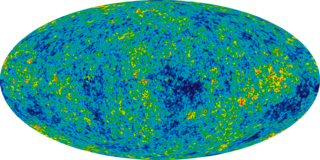
Marc Aaronson was an American astronomer.
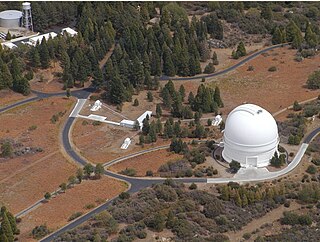
Palomar Observatory is an astronomical research observatory in the Palomar Mountains of San Diego County, California, United States. It is owned and operated by the California Institute of Technology (Caltech). Research time at the observatory is granted to Caltech and its research partners, which include the Jet Propulsion Laboratory (JPL), Yale University, and the National Astronomical Observatories of China.

Catalina Sky Survey is an astronomical survey to discover comets and asteroids. It is conducted at the Steward Observatory's Catalina Station, located near Tucson, Arizona, in the United States.
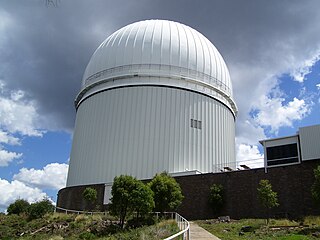
The Australian Astronomical Observatory (AAO), formerly the Anglo-Australian Observatory, was an optical and near-infrared astronomy observatory with its headquarters in North Ryde in suburban Sydney, Australia. Originally funded jointly by the United Kingdom and Australian governments, it was managed wholly by Australia's Department of Industry, Innovation, Science, Research and Tertiary Education. The AAO operated the 3.9-metre Anglo-Australian Telescope (AAT) and 1.2-metre UK Schmidt Telescope (UKST) at Siding Spring Observatory, located near the town of Coonabarabran, Australia.
Robert H. McNaught is a Scottish-Australian astronomer at the Research School of Astronomy and Astrophysics of the Australian National University (ANU). He has collaborated with David J. Asher of the Armagh Observatory.

A Schmidt camera, also referred to as the Schmidt telescope, is a catadioptric astrophotographic telescope designed to provide wide fields of view with limited aberrations. The design was invented by Bernhard Schmidt in 1930.

Siding Spring Observatory near Coonabarabran, New South Wales, Australia, part of the Research School of Astronomy & Astrophysics (RSAA) at the Australian National University (ANU), incorporates the Anglo-Australian Telescope along with a collection of other telescopes owned by the Australian National University, the University of New South Wales, and other institutions. The observatory is situated 1,165 metres (3,822 ft) above sea level in the Warrumbungle National Park on Mount Woorat, also known as Siding Spring Mountain. Siding Spring Observatory is owned by the Australian National University (ANU) and is part of the Mount Stromlo and Siding Spring Observatories research school.

Mount Stromlo Observatory located in the west of Canberra, Australia, is part of the Research School of Astronomy and Astrophysics at the Australian National University (ANU). Australia's oldest telescope and several others at the observatory were destroyed by bushfire in 2003.
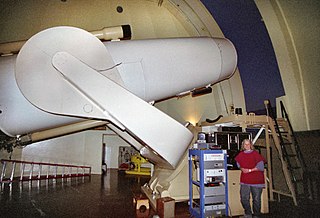
The Samuel Oschin telescope, also called the Oschin Schmidt, is a 48-inch-aperture (1.22 m) Schmidt camera at the Palomar Observatory in northern San Diego County, California, United States. It consists of a 49.75 inches (1.264 m) Schmidt corrector plate and a 72 inches (1.8 m) (f/2.5) mirror. The instrument is strictly a camera; there is no provision for an eyepiece to look through it. It originally used 10 inches (25 cm) and 14 inches (36 cm) glass photographic plates. Since the focal plane is curved, these plates had to be preformed in a special jig before being loaded into the camera.

The Siding Spring Survey (SSS) was a near-Earth object search program that used the 0.5-metre Uppsala Southern Schmidt Telescope at Siding Spring Observatory, New South Wales, Australia. It was the southern hemisphere counterpart of the Catalina Sky Survey (CSS) located in the Santa Catalina Mountains on Mount Bigelow, near Tucson, Arizona, USA. The survey was the only professional search for dangerous asteroids being made in the Southern Hemisphere.
The Schmidt–Väisälä camera is a type of astronomical telescope intended for wide-field photographic work. It was designed by Finnish physicist Yrjö Väisälä.

Comet McNaught, also known as the Great Comet of 2007 and given the designation C/2006 P1, is a non-periodic comet discovered on 7 August 2006 by British-Australian astronomer Robert H. McNaught using the Uppsala Southern Schmidt Telescope. It was the brightest comet in over 40 years, and was easily visible to the naked eye for observers in the Southern Hemisphere in January and February 2007.

7604 Kridsadaporn, provisional designation 1995 QY2, is an unusual, carbonaceous asteroid and Mars-crosser on a highly eccentric orbit from the outer regions of the asteroid belt, approximately 12 kilometers (7.5 miles) in diameter. It was discovered on 31 August 1995, by Australian astronomer Robert McNaught at Siding Spring Observatory near Coonabarabran, Australia. Due to its particular orbit, the C-type asteroid belongs to MPC's list of "other" unusual objects, and has been classified as an "asteroid in cometary orbit", or ACO. The asteroid was named in memory of Thai astronomer Kridsadaporn Ritsmitchai.
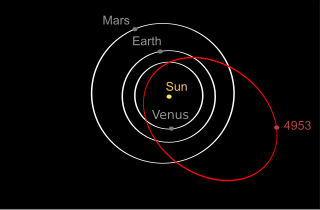
(4953) 1990 MU is a large Earth-crossing asteroid (ECA) belonging to the Apollo group of near-Earth objects which also cross the orbits of Mars and Venus. At approximately 3 km in diameter, it is one of the largest known ECAs. It has been assigned a permanent number from the Minor Planet Center (4953) indicating that its orbit has been very well determined. With an observation arc of 45 years, the asteroid's trajectory and uncertainty regions are well known through to the year 2186.
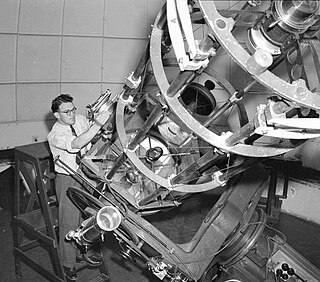
Sidney Charles Bartholemew "Ben" Gascoigne was a New Zealand-born optical astronomer and expert in photometry who played a leading role in the design and commissioning of Australia's largest optical telescope, the Anglo-Australian Telescope, which for a time was one of the world's most important astronomical facilities. Born in Napier, New Zealand, Gascoigne trained in Auckland and at the University of Bristol, before moving to Australia during World War II to work at the Commonwealth Solar Observatory at Mount Stromlo in Canberra. He became skillful in the design and manufacture of optical devices such as telescope elements.
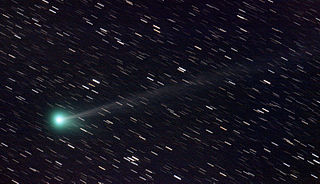
C/2009 R1 (McNaught), one of more than fifty comets known as Comet McNaught, is a non-periodic comet discovered by British-Australian astronomer Robert H. McNaught on September 9, 2009, using the Uppsala Southern Schmidt Telescope at Siding Spring Observatory in New South Wales, Australia. The discovery was confirmed the same day at the Optical Ground Station telescope at Tenerife. After the discovery, earlier images of the comet were found from July 20, August 1, and August 18, 2009. It is believed that C/2009 R1 has left the Solar System permanently.

2012 LZ1 is an asteroid classified as near-Earth object and potentially hazardous asteroid of the Amor group, approximately 1 km (0.62 mi) in diameter. It passed within 5.4 million kilometers (14 lunar distances) of Earth on 14 June 2012. It was discovered during the night of 10–11 June 2012 by astronomer Robert H. McNaught and his colleagues using the 0.5-meter Uppsala Southern Schmidt Telescope at the Siding Spring Observatory in Australia, just four days before its closest approach to Earth.

C/2013 A1 is an Oort cloud comet discovered on 3 January 2013 by Robert H. McNaught at Siding Spring Observatory using the 0.5-meter (20 in) Uppsala Southern Schmidt Telescope.
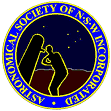
The Astronomical Society of New South Wales (ASNSW) is an amateur astronomy club in the state of New South Wales, Australia, founded in 1954.
Tenagra Observatory and Tenagra Observatory II are astronomical observatories in Cottage Grove, Oregon and Arizona. The observatories house heavily automated robotic telescopes.
















